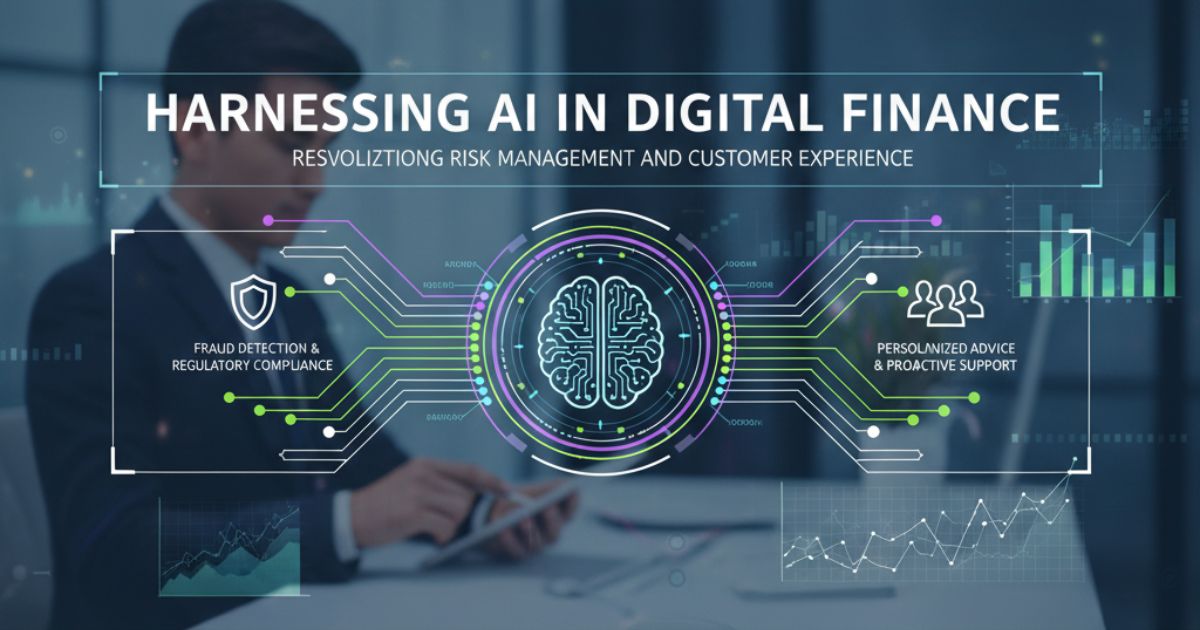Artificial intelligence (AI) is changing digital finance for risk. Banks, fintech companies, and investment firms are using AI to work smarter and safer. Tools like algorithmic trading platforms, fraud detection systems, and automated compliance help manage financial risks effectively. AI also improves customer experience through personalized banking services and predictive insights. By using machine learning, NLP, and risk analytics, businesses can reduce exposure to financial risks, streamline operations, and deliver better value to clients in today’s digital finance ecosystem.
AI-Driven Risk Management in Digital Finance
Risk management has always been a cornerstone of financial services, but AI is taking it to new heights. Institutions can predict potential threats faster and more accurately through advanced data analytics and machine learning models.

Predictive Analytics and Credit Scoring
Traditional credit scoring models rely on a limited set of financial metrics. AI-powered predictive analytics, however, ingests a broader range of structured and unstructured data—transaction histories, social media indicators, and real-time economic signals—to assess creditworthiness more dynamically. Machine learning algorithms continuously refine their predictions based on new data, reducing default rates and expanding access to underserved markets.
Fraud Detection and Prevention
Financial fraud schemes are becoming more sophisticated. AI-driven fraud detection systems employ neural networks and anomaly detection techniques to identify suspicious patterns in transaction data. These systems monitor multiple channels—online payments, wire transfers, and ATM withdrawals—flagging irregular behavior in milliseconds. Real-time alerts enable rapid response, significantly reducing financial losses and safeguarding customer trust.
Enhancing Customer Experience
Beyond risk management, AI is redefining how customers interact with financial services. Personalization, speed, and seamless support are now table stakes in the digital finance landscape.
AI-Powered Chatbots and Virtual Assistants
Chatbots and virtual assistants, driven by natural language processing (NLP), handle routine customer inquiries 24/7. From balance checks to transaction queries, these bots reduce wait times and free human agents for complex issues. Over time, they learn user preferences and conversational nuances, delivering increasingly personalized interactions.
Personalized Financial Insights
Using machine learning, financial apps can analyze spending habits, income streams, and investment portfolios to offer tailored advice, whether suggesting a budgeting plan, recommending investment opportunities, or alerting users to unusual account activity. AI-driven insights foster stronger customer engagement and financial well-being.
Automating Back-End Processes
Operational efficiency is critical in finance. AI automates repetitive tasks, accelerates compliance, and reduces human error across the back office.
KYC and AML Compliance
Know Your Customer (KYC) and Anti-Money Laundering (AML) procedures are time-consuming but essential. AI-driven document recognition and verification tools extract data from IDs, passports, and utility bills, matching them against global watchlists. Machine learning models also monitor transaction flows for money laundering patterns, generating risk scores and automated reports for regulators.
Smart Contracts and Document Processing
Built on blockchain technology, smart contracts automate contract execution once predefined conditions are met. AI enhances this by verifying terms, extracting clauses, and flagging anomalies. This fusion accelerates loan origination, insurance claims processing, and trade finance settlements, driving operational cost savings and faster transaction times.
Challenges and Ethical Considerations

While AI brings numerous advantages, it also introduces challenges that organizations must address responsibly.
- Data Privacy: Financial institutions handle sensitive customer information. Data protection in AI workflows requires robust encryption, secure data storage, and stringent access controls.
- Algorithmic Bias: AI models trained on historical data can perpetuate biases against specific demographics. Continuous monitoring, regular audits, and transparent model documentation help mitigate unfair outcomes.
- Regulatory Compliance: As AI applications evolve, so do regulatory frameworks. Organizations must stay abreast of new guidelines, such as explainability requirements and AI risk management standards to ensure compliance.
- Talent and Expertise: Deploying AI solutions demands data scientists, machine learning engineers, and domain specialists. Investing in training and fostering cross-functional collaboration is essential for successful implementation.
Future Outlook
AI’s role in digital finance will continue to expand, driven by innovations in computing power, data accessibility, and algorithmic research.
- Generative AI for Financial Modeling: Generative models will create synthetic data to stress-test portfolios, simulate market scenarios, and optimize trading strategies without risking real capital.
- Open Banking and API Ecosystems: AI-driven platforms will leverage open banking APIs to aggregate user data across institutions, offering holistic financial insights and enabling cross-platform automation.
- Decentralized Finance (DeFi) Integration: AI will facilitate more brilliant protocol design, automated liquidity management, and risk assessment in DeFi platforms, bridging traditional finance and blockchain-based services.
Learn More: Harnessing AI and Machine Learning: Shaping the Future of Digital Finance
Conclusion
AI is not just an optional upgrade for digital finance—it is the engine driving the next wave of innovation. Financial institutions can achieve greater efficiency, agility, and customer satisfaction by harnessing predictive analytics for risk management, enhancing customer interactions with intelligent assistants, and automating complex back-end operations. However, organizations must navigate ethical considerations, data privacy concerns, and evolving regulations to build trustworthy AI systems. Embracing these challenges today will position businesses to lead in tomorrow’s dynamic digital finance landscape.








Harnessing AI and Machine Learning for Fraud Detection in Digital Finance
Digital Wallets vs. Traditional Banking: What Consumers Need to Know
What Are Digital Finance Tools
Top 10 Fintech Trends To Look Out for 2025
Embedded Finance: How Seamless Financial Services Are Integrating into Everyday Apps
AI-Powered Credit Scoring: Revolutionizing Digital Lending in the Digital Finance Era
Harnessing AI in Digital Finance: Revolutionizing Risk Management and Customer Experience
How Open Banking APIs Are Revolutionizing Digital Finance?